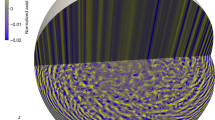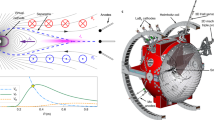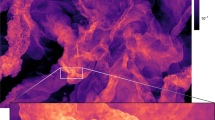Abstract
Isolated large stable vortices have long been observed in the jovian atmosphere and more recently on Saturn. The existence of such stable vortices in strongly turbulent planetary atmospheres is a challenging problem in fluid mechanics. In a numerical simulation Marcus1 found that a single stable vortex developed for a wide variety of conditions in a turbulent shear flow in a rotating annulus. To test this we conducted an experiment on a rotating annulus filled with fluid pumped in the radial direction. The annulus rotates rigidly (there is no differential rotation), but the action of the Coriolis force on the radially pumped fluid produces a counter-rotating jet. Coherent vortices spontaneously form in this turbulent jet, and for a wide range of rotation and pumping rates the flow evolves until only one large vortex remains.
This is a preview of subscription content, access via your institution
Access options
Subscribe to this journal
Receive 51 print issues and online access
$199.00 per year
only $3.90 per issue
Buy this article
- Purchase on Springer Link
- Instant access to full article PDF
Prices may be subject to local taxes which are calculated during checkout
Similar content being viewed by others
References
Marcus, P. S. Nature 331, 693–696 (1988).
Pedlosky, J. Geophysical Fluid Dynamics (Springer, New York, 1979).
Beebe, R. F. & Hockey, T. A. Icarus 67, 96–105 (1986).
MacLow, M. M. & Ingersoll, A. P. Icarus 65, 353–369 (1986).
Mitchell, J. L., Beebe, R. F., Ingersoll, A. P. & Garneau, G. W. J. geophys Res. 86, 8751–8757 (1981).
Williams, G. P. Adv. Geophys. 28A, 381–427 (1985).
Ingersoll, A. P. & Cuong P. G. J. atmos. Sci. 38, 2067–2076 (1981).
Hatzes, A., Wenkert, D. D., Ingersoll, A. P. & Danielson, G.E J. geophys. Res. 86, 8754–8749 (1981).
Flasar, F. M. Icarus 65, 280–303 (1986).
Colin de Verdier, A. Geophys. Astrophys. Fluid Dyn. 15, 213–251 (1980).
McEwan, A. D., Thompson, R. O. R. Y. & Plumb, R. A. J. Fluid Mech. 9, 655–672 (1980).
Antipov, S. V., Nezlin, M. V., Snezhkin, E. N. & Trubinikov, A. S. Nature 323, 238–240 (1986).
Read, P. L. & Hide, R. Nature 308, 45–48 (1984).
Hide, R. & Titman, C. W. J. Fluid Mech. 29, 39–60 (1967).
Rabaud, M. & Couder, Y. J. Fluid Mech. 136, 291–319 (1983).
Maxworthy, T. & Redekopp, L. G. Icarus 29, 261–271 (1976).
Petviashvili, V. I. Soviet Astr. Lett. 9, 137–138 (1983).
Dowling, T. E. & Ingersoll, A. P. J. atmos. Sci. 45 (1988).
Author information
Authors and Affiliations
Rights and permissions
About this article
Cite this article
Sommeria, J., Meyers, S. & Swinney, H. Laboratory simulation of Jupiter's Great Red Spot. Nature 331, 689–693 (1988). https://doi.org/10.1038/331689a0
Received:
Accepted:
Issue Date:
DOI: https://doi.org/10.1038/331689a0
Comments
By submitting a comment you agree to abide by our Terms and Community Guidelines. If you find something abusive or that does not comply with our terms or guidelines please flag it as inappropriate.



